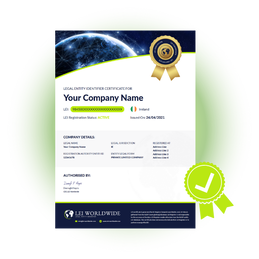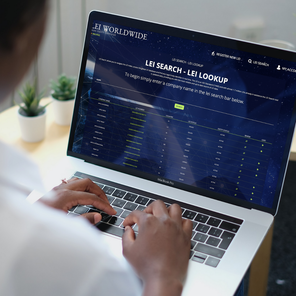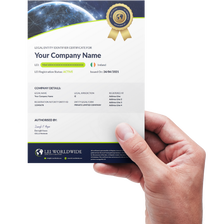What is a Legal Entity Identifier (LEI)A guide to LEI CodesAn LEI is a G20 endorsed, globally verifiable unique identity code. The LEI code contains a record with information about a company such as its identity and group structure. The LEI is currently being adopted as the single most important identifier in the global financial ecosystem. The LEI has far reaching benefits, not only increasing transparency within capital markets, but also in banking, KYC, client onboarding and anti-money laundering. |
What is a Legal Entity Identifier?
Legal Entity Identifier Definition: A Legal Entity Identifier (LEI), is a code that is unique to a legal entity such as a Limited Company, Fund or trust or any organisation. The LEI code consists of a combination of 20 letters and numbers (see the LEI structure here). This code allows each entity to be identified on a global database of entities searchable by number instead of by name, as many entities may have similar or the same name. The LEI is an ISO standard, which is now a legal requirement for many companies within the global financial system.
|
Video Source: GLEIF
|
The LEI is a way of identifying market participants on a single, standarised database. This offers accurate data about a company which is accessible and completely free of charge to use.
A companies LEI record will contain public data such as their name, address, where they are registered, and whether they are a branch, or owned by another 'parent' company. To date, there have been over 2 million LEIs created globally, and it is quickly being adopted as a global standard in business transactions. |
Purpose of the global LEI System (GLEIS)
Previously, it was very difficult to find out about a counterparty if they had no digital presence. This became problematic in the global financial crisis a decade ago.
The lack of transparency put financial institutions in a vulnerable position as vast numbers of entities and funds were unidentifiable. Also, this created complications relating to risk assessment and transparency.
The G20 launched the LEI system in 2011 in order to ensure this would not happen again. The idea was to create a digital database, of all legal entities which was easily accessible, accurate and up to date. One centralized source of information, that contains vast amounts of attainable, high quality data. You can access this freely accessible database by using the LEI Search Tool.
The lack of transparency put financial institutions in a vulnerable position as vast numbers of entities and funds were unidentifiable. Also, this created complications relating to risk assessment and transparency.
The G20 launched the LEI system in 2011 in order to ensure this would not happen again. The idea was to create a digital database, of all legal entities which was easily accessible, accurate and up to date. One centralized source of information, that contains vast amounts of attainable, high quality data. You can access this freely accessible database by using the LEI Search Tool.
Where do LEI numbers come from?
|
After the G20 formed the concept of the Legal Entity Identifier (LEI) Code, the Financial Stability Board (FSB) appointed a new overseeing body to implement it. This organisation is known as the Global Legal Entity Identifier Foundation (GLEIF).
GLEIF were given the role of accrediting and monitoring financial institutions with the ability to issue Legal Entity Identifiers. These institutions, known as Local Operating Units (LOUs) and are the only institutions with the ability to issue LEIs. LOUs may issue LEIs themselves or partner with various Registration Agents such as LEI Worldwide who help facilitate mass adoption to the LEI by providing channels through which legal entities can easily obtain an LEI code. This makes the LEI very easy to obtain, and promotes healthy competition between service providers. See more: The Global LEI System - How it works |
Who needs an LEI?
|
LEIs are required by any legal entity who is involved with financial transactions or operating within todays global financial ecosystem. There are a number of mandates currently in existence which state "no LEI, no trade" meaning both reporting parties and traders require an LEI. The LEI is mandated by a number of EU directives such as EMIR , MiFIR & MIFID II. The US also have similar requirements such as the Dodd Frank Act, the OFR, the Federal Reserve and the Securities & Exchange commission (SEC).
Given that the LEI is becoming more popular, and even more benefits are being realised such as streamlining banking processes and making them more efficient, you will probably end up requiring an LEI in the not so distant future if you don't already. If you are still unsure wether you need an LEI or not, you can read our full guide to who needs an LEI Number here.
To see a list of laws in your country visit: https://www.gleif.org/en/lei-solutions/regulatory-use-of-the-lei |
What benefits are there to obtaining an LEI?
By having an LEI number or LEI certificate, your international recognition and trading credibility is increased immediately. Investors, customers and potential stakeholders can locate your essential LEI data in real time. Likewise, you can benefit from the added layer of security that comes from knowing exactly who you are dealing with.
Having an LEI can ensure your business is compliant with the 184 international regulations mandating the use of a Legal Entity Identifier around the world. The LEI can help to streamline onboarding for financial institutions, who are even now becoming LEI Validation Agents in order to have LEIs issued to new clients quickly and efficiently.
If your organisation has an International Securities Identification Number (ISIN), you can now link you LEI and ISIN codes in a process known as LEI to ISIN Mapping.
Having an LEI can ensure your business is compliant with the 184 international regulations mandating the use of a Legal Entity Identifier around the world. The LEI can help to streamline onboarding for financial institutions, who are even now becoming LEI Validation Agents in order to have LEIs issued to new clients quickly and efficiently.
If your organisation has an International Securities Identification Number (ISIN), you can now link you LEI and ISIN codes in a process known as LEI to ISIN Mapping.
|
Benefits of having an LEI:
✅ Guarantees your existence as a legally registered entity ✅ Internationally compliant to LEI mandates ✅ International business passport ✅ Faster onboarding experience with Financial Institutions ✅ LEI Certificate available |
✅ Increased transparency in financial markets ✅ Brand identity secured ✅ Regulatory reporting requirements ✅ Available to include in Digital Certificates |
How to get a Legal Entity Identifier
Wether you are a financial institution acting on behalf of your clients, or require an LEI for your personal company you can obtain an LEI at www.lei-worldwide.com or by clicking the register button below. Try reading our guide which gives a step by step guide on how to get a Legal Entity Identifier.
The process is very simple and you can complete your LEI application with our registration form below.
The process is very simple and you can complete your LEI application with our registration form below.














